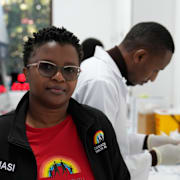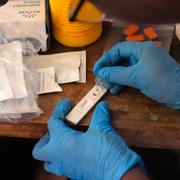
Genombrottet: Två sprutor gav totalt skydd mot hiv
Två sprutor per år med läkemedlet lenacapavir gav hundraprocentigt skydd mot hiv i en studie där omkring 5 000 unga kvinnor i Sydafrika och Uganda deltog. Studien, vars preliminära resultat tidigare har väckt stor uppmärksamhet, har nu publicerats i tidskriften The New England Journal of Medicine.
Svenska statsepidemiologen Magnus Gisslén säger till TT att studien är jätteviktig och har mycket fina resultat.
– Resultatet är väldigt viktigt för möjligheten att i ett bredare perspektiv förebygga hiv i utvecklingsländer. Behandlingen såg också ut att sakna nämnvärda biverkningar, säger Gisslén.
Läs mer
bakgrund
Hiv/aids
Wikipedia (en)
The human immunodeficiency viruses (HIV) are two species of Lentivirus (a subgroup of retrovirus) that infect humans. Over time, they cause acquired immunodeficiency syndrome (AIDS), a condition in which progressive failure of the immune system allows life-threatening opportunistic infections and cancers to thrive. Without treatment, the average survival time after infection with HIV is estimated to be 9 to 11 years, depending on the HIV subtype.
In most cases, HIV is a sexually transmitted infection and occurs by contact with or transfer of blood, pre-ejaculate, semen, and vaginal fluids. Non-sexual transmission can occur from an infected mother to her infant during pregnancy, during childbirth by exposure to her blood or vaginal fluid, and through breast milk. Within these bodily fluids, HIV is present as both free virus particles and virus within infected immune cells.
Research has shown (for both same-sex and opposite-sex couples) that HIV is untransmittable through condomless sexual intercourse if the HIV-positive partner has a consistently undetectable viral load.
HIV infects vital cells in the human immune system, such as helper T cells (specifically CD4+ T cells), macrophages, and dendritic cells. HIV infection leads to low levels of CD4+ T cells through a number of mechanisms, including pyroptosis of abortively infected T cells, apoptosis of uninfected bystander cells, direct viral killing of infected cells, and killing of infected CD4+ T cells by CD8+ cytotoxic lymphocytes that recognize infected cells. When CD4+ T cell numbers decline below a critical level, cell-mediated immunity is lost, and the body becomes progressively more susceptible to opportunistic infections, leading to the development of AIDS.
Omni är politiskt obundna och oberoende. Vi strävar efter att ge fler perspektiv på nyheterna. Har du frågor eller synpunkter kring vår rapportering? Kontakta redaktionen



